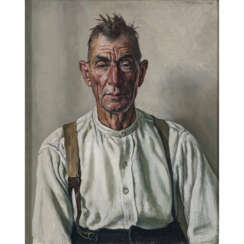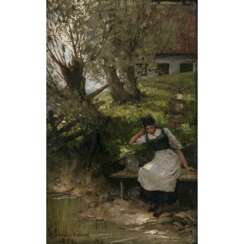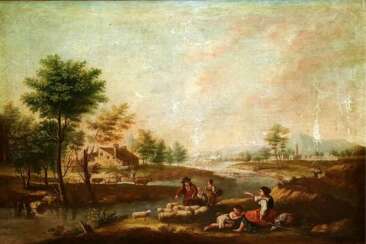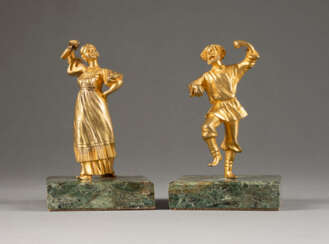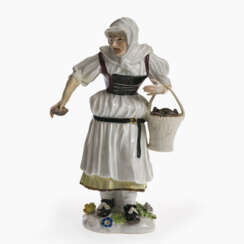old peasant

Paul Mathias Padua was a German painter. He felt committed to the tradition of Wilhelm Leibl, a realist who was highly esteemed by Adolf Hitler, and was extremely successful as an artist during the National Socialist era.


Thomas Baumgartner was a German painter, recognized for his evocative portrayals of rural life. Born in Munich in 1892, he was celebrated for his detailed and vibrant depictions of Bavarian customs and countryside, earning him a place among notable 20th-century German painters.
After training at the Munich Academy and various travels in Europe, Baumgartner established himself with a distinctive style that blended traditional Bavarian influences with his unique artistic vision. His works often featured robust, earthy scenes of peasant life, which not only showcased his technical skill but also conveyed a deep affection for his homeland's landscapes and customs.
Throughout his career, Baumgartner's paintings were widely exhibited and appreciated, particularly for their craftsmanship and the way they captured the essence of rural Germany. His art is a testament to the cultural heritage of Bavaria, resonating with those who value the preservation of regional histories and lifestyles.
Baumgartner's legacy is preserved in art collections and has been featured in major exhibitions, often commanding attention in both national and international art circles. His dedication to depicting the simplicity and beauty of peasant life helps keep the rural traditions of Germany alive in the collective memory of the art world.
For those interested in exploring the serene beauty of traditional German art, Thomas Baumgartner's works offer a timeless journey into the heart of Bavaria's countryside and culture.
To stay updated on upcoming sales and auctions featuring the works of Thomas Baumgartner, consider signing up for our newsletter. This subscription will keep you informed about new opportunities to acquire pieces from this remarkable artist's legacy.


Paul Mathias Padua was a German painter. He felt committed to the tradition of Wilhelm Leibl, a realist who was highly esteemed by Adolf Hitler, and was extremely successful as an artist during the National Socialist era.


Paul Mathias Padua was a German painter. He felt committed to the tradition of Wilhelm Leibl, a realist who was highly esteemed by Adolf Hitler, and was extremely successful as an artist during the National Socialist era.


Georg Eberhard Wolfgang Schuster-Woldan was a German painter and graphic artist, began his artistic education at the Stuttgart Academy of Fine Arts. After a brief interruption due to military service, he continued his studies in Munich and later in Frankfurt. He established a private art school in Munich and gained recognition for his large-scale paintings of legends and fairy tales. Schuster-Woldan later focused on portraiture, particularly of children and women. His works were highly regarded and exhibited prominently, notably at the Glaspalast in Munich.



Felix Mendelssohn (full name Jakob Ludwig Felix Mendelssohn Bartholdy) was a German composer, pianist, conductor, teacher, and one of the greatest representatives of Romanticism in music.
Felix was born into a Jewish musical family that later converted to Christianity. He received a versatile education and already as a child wrote many musical compositions, including 5 operas, 11 symphonies for string orchestra, concertos, sonatas and fugues. Mendelssohn's first public performance took place in Berlin in 1818, when he was nine years old. In 1821 Mendelssohn was introduced to J.W. von Goethe, for whom he performed works by J.S. Bach and Mozart and to whom he dedicated his Piano Quartet No. 3 in B minor. A friendship developed between the famous wise poet and the 12-year-old musician.
A few years later, the talented musician began conducting in various orchestras in Europe, and became acquainted with Carl Weber. In England, where Mendelssohn visited very often, by the middle of the 19th century his music had become very popular, even with Queen Victoria he was the most favorite composer. He dedicated his Symphony No. 3 in A minor major (Scottish Symphony) to the Queen.
Among Mendelssohn's most famous works are A Midsummer Night's Dream (1826), the Italian Symphony (1833), a violin concerto (1844), two piano concertos (1831, 1837), the oratorio Elijah (1846) and several chamber pieces. The tradition of playing the "Wedding March" from A Midsummer Night's Dream in wedding processions dates back to its performance at the wedding of a royal princess in 1858, already after Mendelssohn's death.
In 1843, Mendelssohn founded a conservatory in Leipzig, where he taught composition with Schumann. Mendelssohn was one of the first great Romantic composers of the nineteenth century.





David Teniers the Younger was a Flemish Baroque painter, printmaker, draughtsman, miniaturist painter, staffage painter, copyist and art curator. He was an extremely versatile artist known for his prolific output. He was an innovator in a wide range of genres such as history painting, genre painting, landscape painting, portrait and still life. He is now best remembered as the leading Flemish genre painter of his day. Teniers is particularly known for developing the peasant genre, the tavern scene, pictures of collections and scenes with alchemists and physicians.
He was court painter and the curator of the collection of Archduke Leopold Wilhelm, the art-loving Governor General of the Habsburg Netherlands. He created a printed catalogue of the collections of the Archduke. He was the founder of the Antwerp Academy, where young artists were trained to draw and sculpt in the hope of reviving Flemish art after its decline following the death of the leading Flemish artists Rubens and Anthony van Dyck in the early 1640s. He influenced the next generation of Northern genre painters as well as French Rococo painters such as Antoine Watteau.



